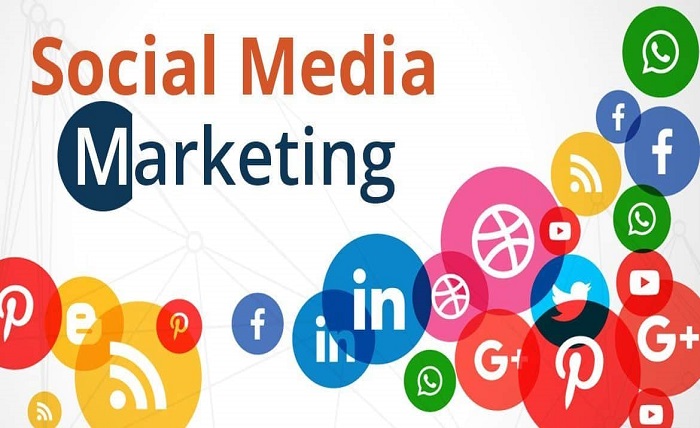Top 5 social media Marketing platforms: Strategies for Building a Strong Online Presence

Social media has become an integral part of our daily lives, with billions of people using platforms like Facebook, Instagram, Twitter, and LinkedIn to connect with friends and family, stay informed, and discover new products and services. As a result, social media has also become an essential tool for businesses looking to build a strong online presence, reach new customers, and drive sales. In this article, we will explore the power of social media marketing and discuss strategies for building a strong online presence.
One of the main benefits of social media marketing is the ability to reach a large and diverse audience. With billions of active users on platforms like Facebook and Instagram, businesses can target specific demographics, interests, and behaviors, making it easier to reach the right people at the right time. Additionally, social media platforms offer a range of advertising options, including sponsored posts, video ads, and influencer marketing, which can help businesses to reach even more people.
Another key benefit of social media marketing is the ability to engage with customers in real-time. Social media platforms provide businesses with the opportunity to respond to customer inquiries, complaints, and feedback in real-time, which can help to build trust and loyalty. Additionally, social media platforms allow businesses to run contests, giveaways, and other promotions, which can help to increase engagement and drive sales.
To build a strong online presence, businesses must also focus on creating and sharing high-quality content. This includes everything from blog posts, videos, and infographics, to social media updates and ad campaigns. The key is to create content that is relevant, engaging, and valuable to your target audience. This will help to increase brand awareness, drive traffic to your Web Designer Dubai, and ultimately, lead to more conversions.
Additionally, businesses must also work on building a strong brand on social media. This includes creating a consistent look and feel across all platforms, using the same logo, colors, and messaging. Additionally, businesses should strive to create a strong, recognizable voice and tone for their brand, which will help to set them apart from competitors.
Social media marketing also requires a long-term commitment, which means businesses must be prepared to put in the time and effort necessary to build a strong online presence. This includes regularly updating their social media profiles, creating and sharing high-quality content, and engaging with customers. Additionally, businesses should also be prepared to invest in paid advertising and other promotional activities, which can help to boost visibility and reach.
In today’s digital age, social media has become an essential tool for businesses looking to build a strong online presence, reach new customers, and drive sales. With so many platforms to choose from, it can be overwhelming to decide which ones to focus on. Here are the top 5 social media marketing platforms that businesses should consider:

-
Facebook
Facebook is one of the most popular and powerful social media marketing platforms, with over 2 billion monthly active users. It offers a wide range of advertising options, making it a great tool for reaching a large and diverse audience. Here are some strategies for using Facebook to market your business:
- Create a Business Page: The first step in using Facebook to market your business is to create a business page. This is separate from your personal profile and is where you will share information about your company, products, and services.
- Develop a content strategy: Once you have your business page set up, it’s important to develop a content strategy. This should include a mix of informative and engaging posts, such as company updates, industry news, and customer testimonials. You should also include calls-to-action in your posts, encouraging people to visit your website or make a purchase.
- Use Facebook Advertising: Facebook advertising is one of the most effective ways to reach a large and targeted audience. You can choose to run ads in the form of sponsored posts, video ads, carousel ads, and more, targeting specific demographics, interests, behaviors and locations.
- Use Facebook Insights: Facebook Insights is a free tool that allows you to track the performance of your business page. This can help you to understand how your content is performing and make data-driven decisions about your marketing strategy.
- Engage with your audience: Engaging with your audience is an important part of building a strong online presence on Facebook. This includes responding to comments and messages, running contests and giveaways, and posting regular updates about your business.
- Utilize Facebook Live: Facebook Live is a great way to connect with your audience in real-time. This feature allows you to live-stream video from your business page and engage with viewers in real-time. This can be an effective way to generate buzz and increase engagement.
Facebook is a powerful social media marketing platform that offers a wide range of advertising options and targeting options. By creating a business page, developing a content strategy, utilizing Facebook advertising, and engaging with your audience, you can increase brand awareness, drive traffic to your website, and ultimately, lead to more conversions.

-
Instagram
Instagram is a highly visual social media platform that has over 1 billion monthly active users. It is perfect for businesses in the fashion, beauty, and lifestyle industries and offers a range of advertising options. Here are some strategies for using Instagram to market your business:
- Create a Business Profile: The first step in using Instagram to market your business is to create a business profile. This will allow you to add contact information, such as your phone number and email address, as well as access to Instagram’s analytics tools.
- Develop a visually appealing aesthetic: Instagram is a highly visual platform, so it’s important to develop a visually appealing aesthetic for your profile and content. This should include high-quality images and videos that are in line with your brand identity and showcase your products or services.
- Use Instagram Stories: Instagram Stories is a great way to connect with your audience in real-time and share behind-the-scenes content. You can also use Instagram Stories to run polls, ask questions, and share exclusive offers.
- Utilize Instagram Advertising: Instagram Advertising is a powerful way to reach a large and targeted audience. You can choose to run ads in the form of sponsored posts, stories, IGTV and Reels. You can also target specific demographics, interests, behaviors and locations.
- Use Instagram Insights: Instagram Insights is a free tool that allows you to track the performance of your account. This can help you to understand how your content is performing and make data-driven decisions about your marketing strategy.
- Engage with your audience: Engaging with your audience is an important part of building a strong online presence on Instagram. This includes responding to comments and messages, running contests and giveaways, and posting regular updates about your business.
- Collaborate with influencers: Influencer marketing is a powerful way to reach a new audience on Instagram. By collaborating with influencers, you can increase brand awareness, drive traffic to your website, and ultimately lead to more conversions.
Creating a business profile, developing a visually appealing aesthetic, utilizing Instagram advertising, and engaging with your audience, you can increase brand awareness, drive traffic to your website, and ultimately lead to more conversions.

-
Twitter
Twitter is a microblogging platform that has over 330 million monthly active users. It is a powerful tool for businesses looking to increase brand awareness and engage with their target audience. Here are some strategies for using Twitter to market your business:
- Create a Business Profile: The first step in using Twitter to market your business is to create a business profile. This will allow you to add contact information and access to Twitter’s analytics tools.
- Develop a content strategy: Once you have your business profile set up, it’s important to develop a content strategy. This should include a mix of informative and engaging tweets, such as company updates, industry news, and customer testimonials. You should also include calls-to-action in your tweets, encouraging people to visit your website or make a purchase.
- Use Twitter Advertising: Twitter Advertising is a powerful way to reach a large and targeted audience. You can choose to run ads in the form of sponsored tweets, promoted accounts and promoted trends targeting specific demographics, interests, behaviors and locations.
- Use Twitter Analytics: Twitter Analytics is a free tool that allows you to track the performance of your account. This can help you to understand how your content is performing and make data-driven decisions about your marketing strategy.
- Engage with your audience: Engaging with your audience is an important part of building a strong online presence on Twitter. This includes responding to mentions, running contests and giveaways, and posting regular updates about your business.
- Utilize Hashtags: Hashtags are a great way to increase the visibility of your tweets and connect with a larger audience. By using relevant and popular hashtags, you can increase the chances of your tweets being seen by people outside of your immediate followers.
- Live-Tweeting: Live-tweeting events such as conferences, product launches, and other industry events is a great way to engage with your audience and increase brand awareness.

-
LinkedIn
LinkedIn is a professional networking platform that has over 740 million monthly active users. It is a powerful tool for businesses looking to increase brand awareness, generate leads, and recruit new talent. Here are some strategies for using LinkedIn to market your business:
- Create a Business Profile: The first step in using LinkedIn to market your business is to create a business profile. This will allow you to add company information, such as your website and contact information, as well as access to LinkedIn’s analytics tools.
- Develop a Company Page: Once you have your business profile set up, it’s important to develop a company page. This should include a mix of informative and engaging content, such as company updates, industry news, and employee testimonials.
- Use LinkedIn Advertising: LinkedIn Advertising is a powerful way to reach a large and targeted audience. You can choose to run ads in the form of sponsored posts and sponsored InMail targeting specific demographics, interests, behaviors and locations.
- Use LinkedIn Analytics: LinkedIn Analytics is a free tool that allows you to track the performance of your page. This can help you to understand how your content is performing and make data-driven decisions about your marketing strategy.
- Engage with your audience: Engaging with your audience is an important part of building a strong online presence on LinkedIn. This includes responding to comments and messages, running contests and giveaways, and posting regular updates about your business.
- Use LinkedIn Groups: LinkedIn Groups is a feature that allows you to join or create groups focused on specific topics. By participating in relevant groups, you can increase your visibility, build relationships with potential customers, and establish yourself as an industry expert.
- Employee Advocacy: Encourage your employees to share company updates, news and other relevant content on their personal LinkedIn profiles. This can help increase the visibility of your company and build trust with potential customers.

-
YouTube
YouTube is a video-sharing platform that has over 2 billion monthly active users. It is a powerful tool for businesses looking to increase brand awareness, drive website traffic, and generate leads. Here are some strategies for using YouTube to market your business:
- Create a Channel: The first step in using YouTube to market your business is to create a channel. This will allow you to upload videos, add a channel banner, and access to YouTube’s analytics tools.
- Develop a content strategy: Once you have your channel set up, it’s important to develop a content strategy. This should include a mix of informative and engaging videos, such as product demos, customer testimonials, and behind-the-scenes footage. You should also include calls-to-action in your videos, encouraging people to visit your website or make a purchase.
- Use YouTube Advertising: YouTube Advertising is a powerful way to reach a large and targeted audience. You can choose to run ads in the form of video ads, overlay ads and sponsored cards targeting specific demographics, interests, behaviors and locations.
- Use YouTube Analytics: YouTube Analytics is a free tool that allows you to track the performance of your channel. This can help you to understand how your content is performing and make data-driven decisions about your marketing strategy.
- Engage with your audience: Engaging with your audience is an important part of building a strong online presence on YouTube. This includes responding to comments, running contests and giveaways, and posting regular updates about your business.
- Optimize your videos for SEO: Optimizing your videos for SEO can help increase visibility and drive traffic to your channel. This includes using relevant keywords in your video titles, descriptions and tags, as well as adding closed captions and transcripts to your videos.
- Collaborate with other creators: Collaborating with other creators in your niche can help you reach new audiences and gain exposure for your brand.


